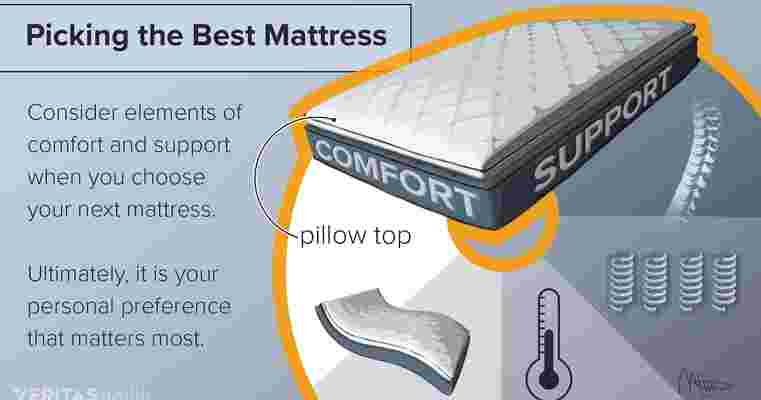Selecting the Best Mattress
Mattress options have expanded significantly in recent years. Innerspring mattresses are still common, but mattresses made of memory foam (composed mostly of polyurethane) and latex (derived from rubber or a synthetic) are now available. Other options include waterbeds, airbeds with customizable firmness, and futons.

See Considerations When Buying a New Mattress
advertisement
Common Mattress Types
Features, materials, and construction of the most common types of mattresses vary considerably.
Innerspring mattresses are the most popular type of mattress, as they provide a traditional bounce feel and strong support from coils. The number of coils, along with the strength of the coils, generally determines the level of support. Typically, varying levels of padding are placed on top for comfort preferences. Some innerspring mattresses with an extra layer of padding are marketed as pillow-top mattresses.
are the most popular type of mattress, as they provide a traditional bounce feel and strong support from coils. The number of coils, along with the strength of the coils, generally determines the level of support. Typically, varying levels of padding are placed on top for comfort preferences. Some innerspring mattresses with an extra layer of padding are marketed as pillow-top mattresses. Latex mattresses are constructed from latex material, providing noticeably more bounce and responsiveness than innerspring mattresses. Users of latex mattresses may experience a comfortable sleep that is cooler than that of a memory foam mattress.
are constructed from latex material, providing noticeably more bounce and responsiveness than innerspring mattresses. Users of latex mattresses may experience a comfortable sleep that is cooler than that of a memory foam mattress. Memory foam mattresses use a firm inner core of memory foam to provide support (with varying levels of cushioning on top). Memory foam provides support that contours to the body and may lead to pressure relief. Because the material adjusts to body temperature, some memory foam mattress users may sleep warm.
use a firm inner core of memory foam to provide support (with varying levels of cushioning on top). Memory foam provides support that contours to the body and may lead to pressure relief. Because the material adjusts to body temperature, some memory foam mattress users may sleep warm. Hybrid mattresses are also available, built with some combination of memory foam or latex layers atop an innerspring mattress. This combination may provide the right mix of support and softness for some people.
are also available, built with some combination of memory foam or latex layers atop an innerspring mattress. This combination may provide the right mix of support and softness for some people. Air beds typically allow each sleeper to adjust the firmness of the bed. Each side of the bed has a separate chamber of air, which can be increased or decreased as desired, and provides the core support. It is important to consider the amount of padding above the air-filled area, as this is crucial to comfort. One potential drawback is that a leak in the air chamber can render the bed unusable.
typically allow each sleeper to adjust the firmness of the bed. Each side of the bed has a separate chamber of air, which can be increased or decreased as desired, and provides the core support. It is important to consider the amount of padding above the air-filled area, as this is crucial to comfort. One potential drawback is that a leak in the air chamber can render the bed unusable. Adjustable beds allow owners to raise or lower certain parts of the bed. Some people experience more comfort sleeping at a slightly inclined position, while others—back sleepers, in particular—enjoy positioning the bed to give support under the knees. Some adjustable beds include the ability to adjust firmness. Overall, these beds can be helpful for addressing certain back conditions. The mattress and adjustable base are sometimes sold separately. See Considerations Before Buying an Adjustable Bed
Bed manufacturers are continually offering new types of mattresses or adding options to existing products. Testing out various types of beds before making a decision is advised.
Mattress Support and Padding Are Crucial
The two main elements that make up a mattress are the coils/core and the padding. Both features merit further discussion.
Support. The inner part of the mattress—be it coils, inner springs, or a firm core—provides support for the spine. Regarding an innerspring mattress, it is ideal for it to have enough coils to offer adequate support and allow for the natural curves of the spine. In general, the higher number of coils—or the thicker the padding—the higher quality (and more expensive) the mattress. However, this does not mean that it’s necessary to buy the mattress with the highest number of coils and/or thickest padding. As noted on the previous page, mattress preference is influenced by a number of factors, including a person’s specific back condition.
The inner part of the mattress—be it coils, inner springs, or a firm core—provides support for the spine. Regarding an innerspring mattress, it is ideal for it to have enough coils to offer adequate support and allow for the natural curves of the spine. In general, the higher number of coils—or the thicker the padding—the higher quality (and more expensive) the mattress. However, this does not mean that it’s necessary to buy the mattress with the highest number of coils and/or thickest padding. As noted on the previous page, mattress preference is influenced by a number of factors, including a person’s specific back condition. Padding/Comfort. The main function of the padding on top of the mattress is to provide comfort (thick padding may be referred to as a “pillow-top”). The amount of padding is a matter of personal preference—some people prefer thick padding and some thin.
See How to Evaluate a Mattress
advertisement
While it is important that a mattress provides an adequate level support for the spine, personal preference and comfort level are the key factors to consider when selecting a mattress.